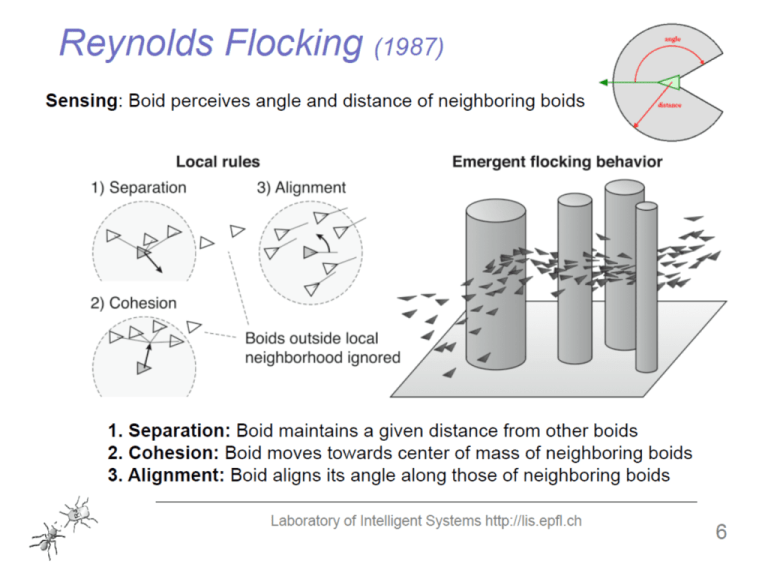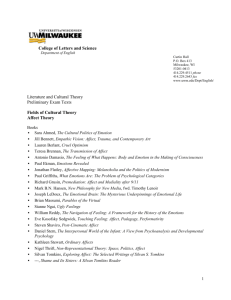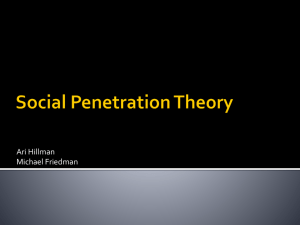Lecture 15
advertisement

ComPlexUs 2003 Spread of Crime Traffic jams Marriage Complex Systems Theory and Methods Agent-based modeling (including cell automata) Chaos, Fractals, & Dynamical systems theory Complex Network science Game Theory Multi-scale modeling Distributed control Nonlinear pattern recognition and data mining Evolutionary, Adaptive, Developmental approaches Bio-inspired Computing (ANNs, EC) Etc. Complex Systems Science is at an exciting time of Maturation Data Collection Technology High-throughput Microarrays Molecular Imaging Distributed Sensor Networks Web mining, Etc. Increasing Recognition of the Limits of Reductionism Computational Capabilities Massive Data Storage Rapid Data Access Processor speed Distributed and parallel computing Etc. Emergenssi Älytekniikan ja konenäön uusia mahdollisuuksia / Pekka Toivanen 12.1.2011 7 Applications • In the security sector affective behavioural cues play a crucial role in establishing or detracting from credibility • In the medical sector, affective behavioural cues are a direct means to identify when specific mental processes are occurring • Neurology (in studies on dependence between emotion dysfunction or impairment and brain lesions) • Psychiatry (in studies on schizophrenia and mood disorders) • Dialog/Automatic call center Environment – to reduce user/customer frustration • Academic learning • Human Computer Interaction (HCI) Zhihong Zeng; Pantic, M.; Roisman, G.I.; Huang, T.S.; , "A Survey of Affect Recognition Methods: Audio, Visual, and Spontaneous Expressions," Pattern Analysis and Machine Intelligence 9 Future Research Directions • So far Context has been overlooked in most Affection Computing researches • Collaboration among Affection researchers from different disciplines • Fast real-time processing • Multimodal detection and recognition to achieve higher accuracy • On/Off focus • Systems that can model conscious and subconscious user behaviour Rafael A. Calvo, Sidney D'Mello, "Affect Detection: An Interdisciplinary Review of Models, Methods, and Their Applications 10 Context Aware Multimodal Affection Analysis Based Smart Learning Environment 11 Output Reading Behavior Report Lesson Length Suggestion Voice Analysis System Controller Class Efficiency Report Hardware Calibration Manager Face Analysis Multimedia Note Posture Analysis Physiology Analysis Decision Support System Multimodal Affect Input Application System Architecture Parameter Adjustment 12 Driver Emotion Aware Multiple Agent Controlled Automatic Vehicle 13 Basic Emotions Complex Emotions Stress Level Feature Estimator Alert the Driver Audio Driving Aid Agent Speed, ABS, Traction Control Navigation Agent Route Selection Safety Agent Notify in case of Emergency Feature Detector Linguistic / Non-linguistic Facial Expression •Steering Movement •Interaction with Gas / Break Paddle Seat Pressure Feature Detector …… Actions …………... Bio-signals Feature Detector Inter agent communication to aid decision making Music, Climate Control Affective Multimedia Agent 14 14 Affective Computing Concerned Issues Privacy concerns [4] [5] I do not want the outside world to know what goes through my mind…Twitter is the limit Ethical concerns [5] Robot nurse or caregivers capable of effective feedback Risk of misuse of the technology In the hand of impostors Computers start to make emotionally distorted, harmful decisions [18] Complex technology Effectiveness is still questionable, risk of false interpretation 15 Conclusion Strategic Business Insight (SBI) – “Ultimately, affective-computing technology could eliminate the need for devices that today stymie and frustrate users… Affective computing is an important development in computing, because as pervasive or ubiquitous computing becomes mainstream, computers will be far more invisible and natural in their interactions with humans.” [4] Toyota’s thought controlled wheelchair [19] 16 Picard, R. 1995. Affective Computing. M.I.T Media Laboratory Perceptual Computing Section Technical Report Picard, R. 1995. Affective Computing. The MIT Press 17 18 References [1] Picard, R. 1995. Affective Computing. M.I.T Media Laboratory Perceptual Computing Section Technical Report No. 321 [2] Picard, R. 1995. Affective Computing. The MIT Press. ISBN-10: 0-262-66115-2. [3] Picard, R., & Klein, J. (2002). Computers that recognize and respond to user emotion: Theoretical and practical implications. Interacting With Computers, 14, 141-169. [4] http://www.sric-bi.com/ [5] Bullington, J. 2005. ‘Affective’ computing and emotion recognition systems: The future of biometric surveillance? Information Security Curriculum Development (InfoSecCD) Conference '05, September 23-24, 2005, Kennesaw, GA, USA. [6] Boehner, K., DePaula, R., Dourish, P. & Sengers, P. 2005. Affect: From Information to Interaction. AARHUS’05 8/21-8/25/05 Århus, Denmark. [7] Zeng, Z. et al. 2004. Bimodal HCI-related Affect Recognition. ICMI’04, October 13–15, 2004, State College, Pennsylvania, USA. [8] Taleb, T.; Bottazzi, D.; Nasser, N.; , "A Novel Middleware Solution to Improve Ubiquitous Healthcare Systems Aided by Affective Information," Information Technology in Biomedicine, IEEE Transactions on , vol.14, no.2, pp.335-349, March 2010 [9] Khosrowabadi, R. et al. 2010. EEG-based emotion recognition using self-organizing map for boundary detection. International Conference on Pattern Recognition, 2010. [10] R. Cowie, E. Douglas, N. Tsapatsoulis, G. Vostis, S. Kollias, w. Fellenz and J. G. Taylor, Emotion Recognition in Human-computer Interaction. In: IEEE Signal Processing Magazine, Band 18 p.32 - 80, 2001. [11] Rafael A. Calvo, Sidney D'Mello, "Affect Detection: An Interdisciplinary Review of Models, Methods, and Their Applications," IEEE Transactions on Affective Computing, pp. 18-37, January-June, 2010 [12] Zhihong Zeng; Pantic, M.; Roisman, G.I.; Huang, T.S.; , "A Survey of Affect Recognition Methods: Audio, Visual, and Spontaneous Expressions," Pattern Analysis and Machine Intelligence, IEEE Transactions on , vol.31, no.1, pp.39-58, Jan. 2009 [13] Norman, D.A. (1981). ‘Twelve issues for cognitive science’, Perspectives on Cognitive Science, Hillsdale, NJ: Erlbaum, pp.265–295. [14] R. Sharma, V. Pavlovic, and T. Huang. Toward multimodal human-computer interface. In Proceedings of the IEEE, 1998. [15] Vesterinen, E. (2001). Affective Computing. Digital media research seminar, spring 2001: “Space Odyssey 2001”. 19 References [16] Burkhardt, F.; van Ballegooy, M.; Engelbrecht, K.-P.; Polzehl, T.; Stegmann, J.; , "Emotion detection in dialog systems: Applications, strategies and challenges," Affective Computing and Intelligent Interaction and Workshops, 2009. ACII 2009. 3rd International Conference on , vol., no., pp.1-6, 10-12 Sept. 2009 [17] Leon, E.; Clarke, G.; Sepulveda, F.; Callaghan, V.; , "Optimised attribute selection for emotion classification using physiological signals," Engineering in Medicine and Biology Society, 2004. IEMBS '04. 26th Annual International Conference of the IEEE , vol.1, no., pp.184-187, 1-5 Sept. 2004 [19] http://www.engadget.com/2009/06/30/toyotas-mind-controlled-wheelchair-boast-fastest-brainwave-anal/ [20] http://www.w3.org/TR/2009/WD-emotionml-20091029/ [21] M. Pantic, N. Sebe, J. F. Cohn, and T. Huang. Affective multimodal human-computer interaction. In ACM International Conference on Multimedia (MM), 2005. [22] Gong, L., Wang, T., Wang, C., Liu, F., Zhang, F., and Yu, X. 2010. Recognizing affect from non-stylized body motion using shape of Gaussian descriptors. In Proceedings of the 2010 ACM Symposium on Applied Computing (Sierre, Switzerland, March 22 - 26, 2010). SAC '10. ACM, New York, NY, 1203-1206. [23] Khalili, Z.; Moradi, M.H.; , "Emotion recognition system using brain and peripheral signals: Using correlation dimension to improve the results of EEG," Neural Networks, 2009. IJCNN 2009. International Joint Conference on , vol., no., pp.1571-1575, 1419 June 2009 [24] Huaming Li and Jindong Tan. 2007. Heartbeat driven medium access control for body sensor networks. In Proceedings of the 1st ACM SIGMOBILE international workshop on Systems and networking support for healthcare and assisted living environments (HealthNet '07). ACM, New York, NY, USA, 25-30. [25] Ghandi, B.M.; Nagarajan, R.; Desa, H.; , "Facial emotion detection using GPSO and Lucas-Kanade algorithms," Computer and Communication Engineering (ICCCE), 2010 International Conference on , vol., no., pp.1-6, 11-12 May 2010 [26] Lucey, P.; Cohn, J.F.; Kanade, T.; Saragih, J.; Ambadar, Z.; Matthews, I.; , "The Extended Cohn-Kanade Dataset (CK+): A complete dataset for action unit and emotion-specified expression," Computer Vision and Pattern Recognition Workshops (CVPRW), 2010 IEEE Computer Society Conference on , vol., no., pp.94-101, 13-18 June 2010 [27] Ruihu Wang; Bin Fang; , "Affective Computing and Biometrics Based HCI Surveillance System," Information Science and Engineering, 2008. ISISE '08. International Symposium on , vol.1, no., pp.192-195, 20-22 Dec. 2008 20 24 • Pepper is a humanoid robot by Aldebaran Robotics and SoftBank Mobile designed with the ability to read emotions. • It was introduced in a conference on 5 June 2014, and has been showcased to the public at Softbank mobile stores in Japan since 6 June. • It will be available on February 2015 at a base price of JPY 198,000 ($1,931) at Softbank Mobile stores. • Pepper's emotion comes from the ability to analyze expressions and voice tones. • The robot’s head has • 4 microphones, • 2 HD cameras (in the mouth and forehead), and • a 3-D depth sensor (behind the eyes). • There is a gyroscope in the torso and touch sensors in the head and hands. • The mobile base has two sonars, six lasers, three bumper sensors, and a gyroscope. https://www.youtube.com/watch?v=kCFYw8mIqcc RoboCup RoboCup is an international research effort to promote autonomous robots. • Robots must cooperate in… – – – – Strategy acquisition Real-time reasoning Multi-agent collaboration Competition against another team of robots RoboCup • Each robot has… – Pentium 233MHz – Linux OS – Video camera and frame grabber – Sensor System – Kicker How to the robots make decisions? • Control is based on a set of behaviors • Each behavior has a set of preconditions that either… – Must be satisfied – Are desired • A behavior is selected when all of the “musts” become true • A behavior is selected from several behaviors based on how many desired conditions are true Applications of AI and Robotics • • • • • • • Industrial Automation Services for the Disabled Vision Systems Planetary Exploration Mine Site Clearing Law Enforcement And Many Others… Älytekniikan ja konenäön uusia mahdollisuuksia / Pekka Toivanen 48 Älytekniikan ja konenäön uusia mahdollisuuksia / Pekka Toivanen 49 https://www.youtube.com/watch?v=3IFuv1AVouM https://www.youtube.com/watch?v=hlHrvQ7D5OU http://time.com/2917394/japan-human-robots/#2917394/japan-humanrobots/ https://wtvox.com/robotics/top-10-humanoid-robots/ https://www.youtube.com/watch?v=IhVu2hxm07E



